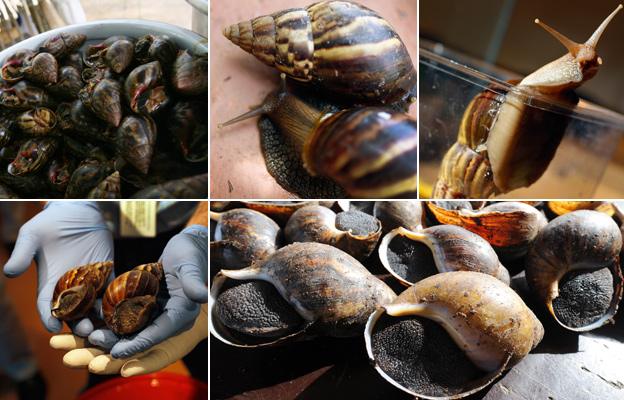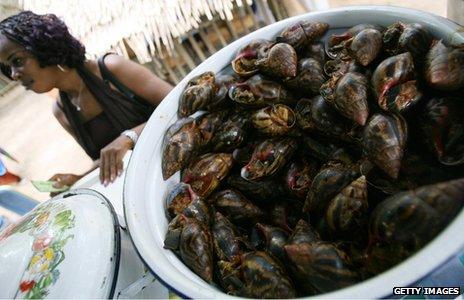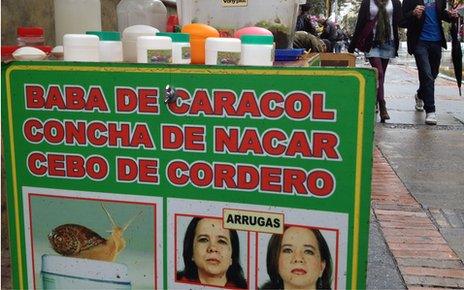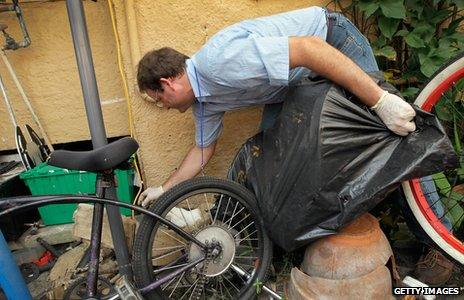African snail: Deadly invasion in South America
- Published

An African snail appears to be on a campaign to conquer central and southern America. But how much mess can a mollusc make - and are they really deadly to humans?
At an average size of just a couple of inches long, the so-called giant African land snail (achatina fulica) probably wouldn't qualify for a starring role in a 1950s horror film, but it is still wreaking havoc in several South American countries and the US state of Florida.
The threat lies in its ability to multiply at enormous speed. The snails reach maturity after a year and can then produce 200-300 eggs a month, leading to huge infestations within a short space of time. The snails, which are native to East Africa, appear on the International Union for Conservation of Nature's list of the world's top 100 invasive species.
In one Colombian town alone, Buenaventura, more than eight tonnes of snails have been collected since an invasion began two years ago. In Ecuador the problem is so widespread that they have been found in half of the country's 24 provinces, including the Galapagos Islands.
In the fields, they are an agricultural nuisance. In the cities, they clutter up the sidewalks and rip the stucco off houses. Such is the density with which they congregate at the height of an invasion, that they have even been known to cause slicks on highways.
But the snails are not just an unsightly pest. They can also kill.
In tropical regions, giant African snails, as well as other types of slugs and snails, can carry a nematode - a kind of parasite - called the rat lungworm. These minute worms, if ingested, enter the circulation and travel to the brain, where they can lead to eosinophilic meningitis.
Symptoms range from headaches to tingling, numbness and involuntary flexing of muscles. In severe cases, sufferers may go into coma and die.
Snails have been blamed for three deaths in Ecuador, out of almost 100 documented cases of the disease in the country. There have also been reported cases in Venezuela, Peru and Brazil. In East Asia, where snails are eaten uncooked or partially cooked, incidences of the syndrome are thought to be much higher.
"People touch the snails and then they touch food and that could be enough," says Professor Luz Elena Velasquez at the University of Antioquia, Colombia.
"And you can come into contact with their slime very easily, because they release a lot of it and they go everywhere. They're not shy at all - they go into houses."
Rob Cowie, a research professor at the University of Hawaii, has devoted the last 20 years to studying molluscs. He remembers meeting "a young surfer guy in his early 20s" who had contracted eosinophilic meningitis two years earlier.

Eating the snails raw or partially cooked could be dangerous
"He was kind of two-thirds recovered. He could walk again, but it was a stumbling walk. And he could talk but it wasn't quite right yet and he kind of didn't look you in the eye. It's just terrible."
It seems the unfortunate man had accidentally eaten a slug in lettuce.
"That's one of the two pathways you get this disease - inadvertently eating a slug in lettuce or something like that. You can have a tiny slug that's just a couple of millimetres long and that could be infested with thousands of worms. And if you don't carefully wash your lettuce, you would swallow those worms."
The other pathway to infection is to come into contact with a slug or snail on purpose, for example by eating one.
In the past the snails were much larger - up to 10in - but nowadays an African snail would make a snack rather than a meal. Prepared properly, they are quite safe to eat. The muscular "foot" of the creature can be cut off, cooked and eaten as a miniature steak - although opinions vary as regards its gastronomic merit.
Raw snail sashimi, on the other hand, is not a good idea at all. It's thought that people in South America do occasionally eat raw snails, either because they have been dared to do so or because of tribal traditions.
"Unfortunately, there is a lot of misinformation about the benefits of snails," says Juan Camilo Restrepo, at the environmental agency of Antioquia in Colombia. "For some, they are an attractive food, because they are very big and a good source of protein.
"But many others believe their slime has infinite healing powers - people use it to treat scars, to fight allergies and so on. They transport it, sell it and keep it at home."
Disgusting as this may sound to some, the belief that snail slime has restorative properties is not a new one. The mid-90s saw an explosion in "wonder creams" from companies processing snail slime on an industrial scale. The cream is used by some people to treat varicose veins and skin blemishes.
According to Rob Cowie, if a snail skin product is manufactured on an industrial scale it is not going to present a health hazard because the nematodes present in the snails will die before the product is put to use.
However, if people are extracting slime from snails for their own use, the situation is different.
"If you're manufacturing slime on a backyard scale, then [the processing time] will be faster and if you're smearing it on your face, there's a chance it could go in your mouth," he says.
"I wouldn't discount the possibility you could get ill that way."
It is thought that the trade in snails for private medicinal or cosmetic use is what caused the outbreak in Colombia in the first place. The creatures were reportedly brought into the country by a "culebrero", a salesman of herbs and animals with supposed healing properties. These salesmen are often seen in South American cities, selling snails and homemade snail creams in jars.

Some people believe the snails hold beauty secrets
The story goes that after a slow day in the market, the culebrero threw his unsold African snails in a dry river bed in Santa Fe de Antioquia, in the north of the country.
Now the infestation has gone beyond the point at which the authorities believe they can realistically do much about it - the giant African snail is in South America for good. Although a clean-up task force is still in operation in Santa Fe, the Colombian government is switching its energies to education campaigns.
"We have to learn how to manage it, full eradication is no longer feasible," Valasquez says.
For her, management means educating the locals about the risks of handling the giant African snail, and learning how to distinguish the dangerous incomer from a local giant snail, the megalobulimus oblongus.
This is, Cowie believes, a mistake, since ultimately the killer is not the giant African snails but the rat lungworm. He believes that whether or not the nematode came to South America with the giant African snail, now that it is there, it could be carried by native snails too.
"A focus on the giant African snail is short-sighted," he says. "There is absolutely no reason why the native megalobulimus could not act as a host for the worm. My guess is that it could do so perfectly well."
However, he agrees with the decision to move away from attempts at total eradication.
"The problem with any of these eradication programmes is getting the last one. You can get rid of a million and just leave three and you've still got a problem."
Nevertheless, that is precisely what they are planning to do a thousand miles north, in the US state of Florida. And for them it's not a new fight - they eliminated the giant African snail once before in the 1960s, after a boy brought three of the creatures back from Hawaii as a gift for his grandmother. She didn't want the snails and so she threw them into the back garden.

The giant African snail has been known to cause damage to stucco
Nine years and $1m (£0.64m) later, they were finally removed - one of only two successful eradication programmes of the snails ever, worldwide.
The state has already spent a similar sum of money since the new invasion began in September 2011. A team of specialists is currently destroying around a thousand snails a week, using a bait of iron phosphate.
Besides the snail-picking, the government is asking the public to help with the clean-up, having distributed "most wanted" posters throughout the state.
Denise Feiber, of the Florida Department of Agriculture, says that they have collected more than 72,000 snails so far.
"So we have spent a lot of resources and as you can see from the numbers collected and their ability to reproduce rapidly, this program will not be wrapped up in a few months," she says. "This will be ongoing for a number of years probably, until we can successfully declare eradication."
But there is one piece of good news for Ecuador, Venezuela, Brazil and Colombia. It seems that the giant African snail follows a trajectory common to many invasive species, in which an explosion in the populations of the creatures is followed by a slow, steady decline.
They will never go away, but they may become what Professor Cowie describes as "just about bearable".
Additional reporting by Arturo Wallace and Julio Garcia